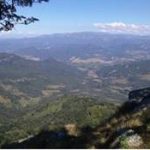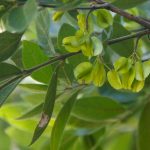TREE LIFE
JULY 2017
MASHONALAND CALENDAR
Future Outings: note to members
Many thanks to those of you who did respond to the questionnaire we sent out last month, from which there was a fair response, enough to give us some ideas.
Botanic Garden walk, first Saturday of the month – the majority wanted this walk to continue and that mornings were preferable to any other time – so mornings it will be, also several people wanted the walk to start earlier – so we are going to try this, starting at 8.15am from August onwards.
Third Sunday outings: We will continue to endeavour to find interesting destinations for our main outing of the month.
Fourth Saturday afternoon: – Quite a few people enjoy this time and the opportunity of visiting interesting gardens or nearby destinations. So we will continue to try to find gardens to visit but will have a standard walk at the Mukuvisi Woodlands, entering by the Blatherwick Gate, if we have not found another venue. Details will be posted in Tree Life, as well as in emails to members just prior to the outing.
For July 2017 the outings will be as follows:
Saturday July 1st: Botanic Garden walk. Meet in the car park at 0845 for a 9.00am start. The walk will last approximately one and a half hours.
Sunday July 16th: The venue for this has yet to be confirmed. You will be notified as soon as final arrangements have been made. Please diarize this date.
Saturday July 22nd: Mukuvisi Woodlands. Meet at the Blatherwick Gate at 14.30. We will go in together so that the gate can be locked while we are inside. Bring tea or a drink to have after the walk.
Looking forward to seeing you all and may our walks continue to be great times together, bound by our common interest in the birds and the bees and the trees, in particular.
Mary Lovemore
Outing to Ewanrigg National Park 18 JUNE 2017
It was a most beautiful chilly blue day and 16 members braved the weather to enjoy a good day at Ewanrigg. We were fairly late getting started because we moved from the far car park to the main picnic area where Tony showed us the trees, mostly exotic, that he and Dave Hartung had been labelling. We were pleased to welcome Penny Raynor and her friend Jenny Mitchell from Marondera, and Sarah’s friend Rachel. We were also delighted to have Vernon and Marilyn back after a long break. Well done Vernon on your recovery.
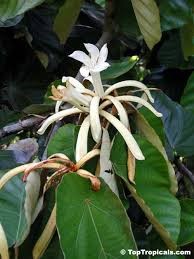
Pterospermum acerifolium – photo Top Tropicals
We really only looked at the trees in the bottom picnic area, most of which have been planted. Carissa edulis, Simple Spine Numnum, with its white latex and single straight spines was the first tree we saw, followed by Prunus cerasoides, Himalayan Cherry, and Callistemon viminalis, Weeping Bottle Brush, MYRTACEAE family. We saw Senna spectabilis, Ficus burkei and Albizia gummifera, the smooth-barked, flat crowned Albizia that is not indigenous to this area. We then looked at a fine specimen of Eucalyptus cinerea (Florists Gum), Citharexylum quadrangulare (Fiddlewood), Vangueria randii and Syzygium guineense subsp. guineense (Woodland Waterberry). There was some discussion over Piliostigma thonningii, the Monkey Bread.
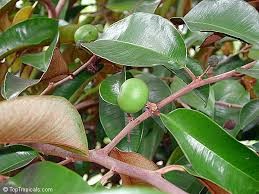
Chrysophyllum cainito – photo Top Tropicals
We then found a very attractive tree, Chrysophyllum cainito (Star apple / Golden-leaf tree) (number 158) growing near the entrance gate. This is a tree with simple leaves that are dark green on top and covered with very rusty / golden hairs below, with old leaves turning red. This tree comes from the greater Antilles and West Indies. Also of interest was Pterospermum acerifolium (Dinner-plate tree) (Number 129) growing near the central car park going up to the restaurant area. A tree with large simple leaves, some of which are peltate, with a few white flowers. This tree comes from South East Asia – India through to Burma.
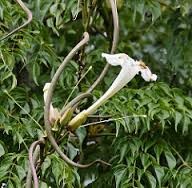
Radermachera sinica – Photo Melbourne22
We then had a very pleasant picnic lunch basking in the warm sunshine, after which members made their own way around the aloe gardens, up to the Herb Wheel and Water Garden. The aloes were spectacular although still not at their very best, in another two weeks they would have been fully open. The whole Botanic Garden of Ewanrigg is looking really good, which is so pleasing in these times of economic crisis and lack of funding for these important treasures of Zimbabwe.
Having gathered back at the cars we decided to go up to the newly opened restaurant near the Water Garden and have a welcome cup of coffee or tea. This restaurant serves a variety of food and drink at very reasonable prices and we were all glad we had stopped there. While having our coffee there was much discussion about Radermachera sinica (China Doll) (Number 204) growing near the restaurant. Tree with tripinnate leaves and long, thin, dry pods comes from China and Taiwan.
All in all a very pleasant day, not much serious botanising, but nevertheless a super day out.
-Mary Lovemore
OUTING TO THE HOLM’S PROPERTY SATURDAY 24th JUNE
On the fourth Saturday outing in June, the Tree Society visited the home of Pip and Nick Holm in Mandara. The centerpiece of their property is a landscaped dam containing a number of interesting aquatic plants. Although water plants are hardly the core business of the Tree Society, I hope no one minds if I mention a couple of interesting species seen.
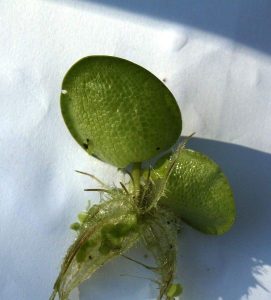
Limnobium laevigatum
One species floating on the surface was the Amazon frogbit, Limnobium laevigatum. Although superficially similar, this is not Kariba weed, Salvinia molesta, which underwent explosive growth on Lake Kariba in 1958, after the construction of the dam wall. This is a newly introduced species, initially spotted in Lake Chivero in 2005, although not named correctly until 2009. It is now in most of the dams close to Harare and often in smaller waterbodies like the small dam on the Chiraura in the Mukuvisi Woodlands and in this dam as well.
More significantly, though, it is now present in Lake Kariba and has been found much further downstream on the Zambezi River as well. Perhaps it is the new Kariba weed? There is now a further record from northern Zambia and it appears that this recent alien plant will go a lot further in Africa in the next few years.
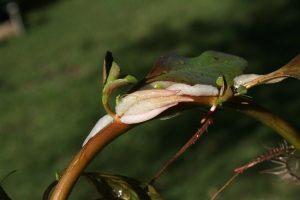
Ludwigia stolonifera Photo:MaryHyde
As is shown in the image, the undersurface of the leaves has a spongy air-filled covering which assists the plant to float.
Also in the dam we saw the floating stems of Ludwigia stolonifera spreading across the water surface. This had been planted here but it is native to Zimbabwe. Like the Amazon frogbit, this plant also has support for its floating stems, namely the unusual and interesting white spongy ‘floats’ on the stems, shown in the accompanying picture.
I would like to thank Pip and Nick for their warm welcome and for the tea and snacks at the end of our walk.
Mark Hyde
TONY ALEGRIA CHAIRMAN


